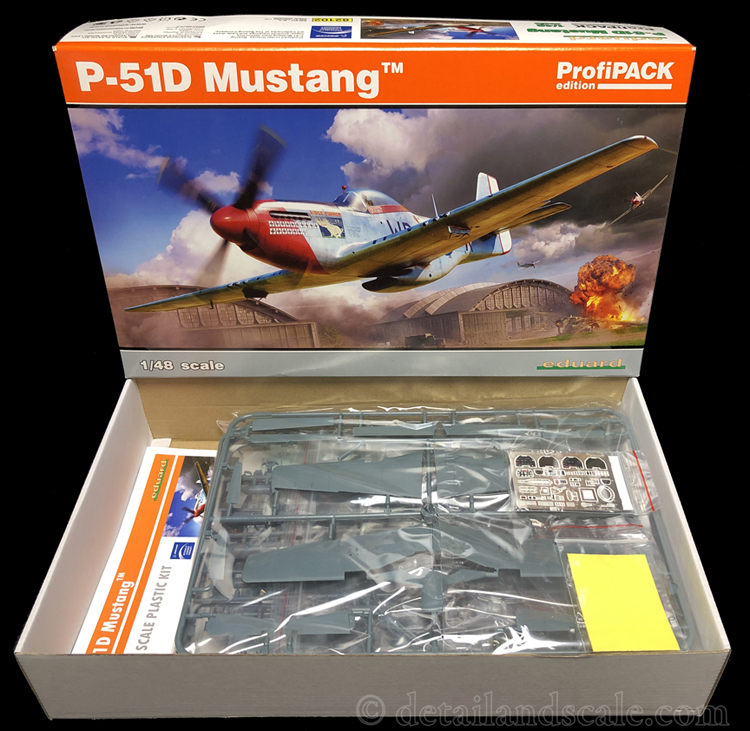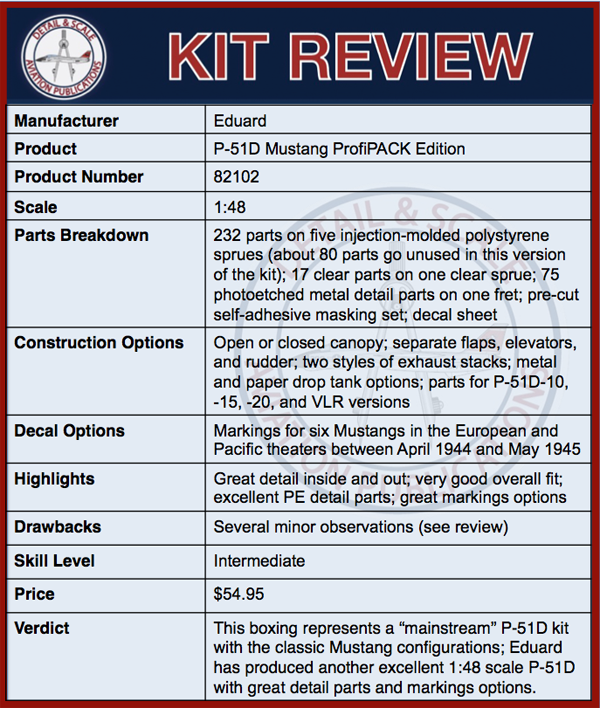Eduard P-51D Mustang ProfiPACK Edition
1:48 Scale


In 2019, Eduard released the first of a growing family of P-51 Mustangs in 1:48 scale, all of which we have reviewed at Detail & Scale (and which you can find HERE). Here, we take a look at their P-51D Mustang ProfiPACK edition kit that arrived earlier this year.

The origins of the P-51 began in early 1940. The U.K. was seeking a stopgap fighter to help hold the line against the German Luftwaffe. Great Britain’s Purchasing Commission, interested in acquiring Curtiss P-40s, approached North American Aviation to build them under license for the RAF. Instead, North American pitched an alternative. They argued they could build a completely new fighter that would be easier and faster to produce, and that would also outperform the P-40. The British accepted the offer and placed an order for 340 of the new aircraft in March 1940. On September 9th, a design team headed by NAA’s “Dutch” Kindelberger and Eduard Schmued finished the prototype NA-73X airframe. It was a rapid developmental process by any standard, even during wartime. A mere 102 days had passed between contract signature and roll-out.
The NA-73X first flew on 26 October 1940. It incorporated a revolutionary laminar flow airfoil wing derived from NACA flight test data and an innovative under-fuselage ducted engine cooling system. Mustangs were very fast, maneuverable, and well-armed. Early versions entered production in May 1941 and went into combat with the RAF 11 months later. These were powered by Allison engines and were typically equipped with two .50-calibre nose-mounted and four .30-calibre wing-mounted machine guns. The 1,100hp Allison V-1710-39 powerplant provided impressive performance, but only up to about 15,000 feet. RAF Mustang Marks I and II were soon followed by the improved P-51As, Bs, and Cs operated by the USAAF and the RAF. British experimentation with the supercharged Merlin powerplant provided for outstanding high-altitude performance, and by mid-1943, Packard-built Merlin engines became standard for new build P-51s.
During WWII, P-51s saw action in the European, North African, Mediterranean, and Pacific theaters. Mustangs claimed 4,950 air-to-air kills. In USAAF service, P-51s, with their very long range, escorted bomber formations over Europe beginning in 1943 and as ground attack and close air support aircraft following D-Day. The definitive P-51D was fitted with a Plexiglas bubble canopy providing excellent 360-degree visibility, and the aircraft could reach around 440 MPH while its service ceiling was just shy of 42,000 feet. Armament consisted of six wing-mounted .50-caliber machine guns while underwing pylons permitted the use of range-extending drop tanks, along with rockets and bombs.
By the start of the Korean War, the Mustang had been re-designated F-51 and it served as the front-line fighter until the F-84 and F-86 arrived on the scene. The “Cadillac of the Skies” served with Air National Guard Units until 1957 and the last Mustang in USAF service was retired in 1978. In foreign service, the Dominican Republic retired its last operational P-51 in 1984. Today, only a handful of P-51s still fly as warbirds with private owners.

Eduard’s 1:48 scale P-51D kit comes on five injection molded polystyrene sprues containing 232 parts (about 80 parts are not used in this version of the kit). Seventeen clear parts come on one clear sprue. It also contains 75 photoetched metal detail parts on one fret (most of them are pre-painted). There’s also a pre-cut, self-adhesive masking set for the windscreen, canopy, and wheel hubs. Markings for six aircraft include:
- P-51D-10 44-14221, “Ridge Runner,” flown by Maj. Pierce McKennon, 335th FS, 4th FG, 8th AF, Debden, United Kingdom, April 1944
- P-51 D-15 44-15449, “American Beauty,” flown by Capt. John J. Voll, 308th FS, 31st FG, 15th AF, San Severo, Italy, November 1944
- P-51D-15, 44-15041, “Petie 3rd” flown by Col. John C- Meyer, 352nd FG, 8th AF, Y-29, Asch Belgium, December 1944
- P-51D-20 44-72218, “Big Beautiful Doll,” flown by Col. John D. Landers, CO of 78th FG, Duxford, United Kingdom, March 1945
- P-51D-20 44-63607, flown by Col. Glenn T. Eagleston, 353rd FS, 354th FG, 9th AF, Y-64, Ober Olm, Germany, April 1945
- P-51D-20 44-63984, “Margaret IV,” flown by, Maj. James B. Tapp, CO of 78th FS, 15th FG, 7th AF, Iwo Jima, May 1945
Strengths: We’ve now recently reviewed several separate issues of the Eduard 1:48 scale Mustang. I would say that this boxing is, in essence, Eduard’s “standard” or “centerpiece” issue of their 1:48 scale P-51D line of kits spanning the Block 10, 15, 20, and VLR (Very Long Range) Mustangs. They all include the tail fillet in the Block 10 and higher along with lots of little subtle differences between them involving particular combinations of antennas, canopy styles, review view mirrors, gunsights, instrument panels, exhaust stacks, and so forth. These include most of the unique VLR parts for markings option F (see below).
All the good things I’ve described about the basic Eduard 1:48 scale Mustang in previous reviews at detailandscale.com apply to this kit as well. As noted in earlier reviews, I think that Eduard can indeed claim “best 1:48 scale P-51D” with this kit, though it is not perfect. To recap, surface details are very accurate. Eduard has nailed the relatively featureless wing surfaces while rivet/fastener details on the fuselage and tail surfaces are as exquisite as they are sublime. Test fitting of the fuselage halves and wings appears airtight. The only fit that seems not virtually seamless involves the upper wing roots. It looks a little fiddly, but I suspect that when all the assemblies come together, the fit should be far more stable.
Eduard’s P-51D has a number of building options, including an open or closed canopy, separate landing flaps, ailerons, rudders, elevators, and radiator exhaust, two canopy styles, the single rear-view mirror, and shrouded or unshrouded exhaust stacks. Optional paper or metal-style external fuel tanks are also provided. Other building options found on the sprues that are not used in this issue of the kit include the uncuffed propeller, bombs, and rockets.
The cockpit features separate frames for the sidewalls, a multi-part seat, and excellent representations of the radio, battery, and fuel tank, down to the separate parts for the wiring and fuel line. The really impressive elements here are the photoetched parts which add a great deal of detail and visually interesting features to the cockpit, such as the pre-painted instrument dial faces, the gorgeous pre-painted harnesses (complete with simulated stitching details), various placards, and the photoetched throttles, trim wheel, and other parts. In sum, the cockpit is a knockout when these detail parts are added.
The main gear well builds up from about 16 parts, and it is very rich with detail, from the textures of the parts and ribs to the fuel lines and pump details. All that’s missing are the smaller hydraulic and electrical lines, and the builder can add those relatively easily if they wish. There’s also a fully enclosed tail wheel well that looks excellent. Another nice feature is a single-piece gun port section on each wing. Unlike the Tamiya kit, for example, the gun barrels do not assemble out of upper and lower halves resulting in some tricky/ugly seam work. Eduard’s engineering approach here is excellent. Also note that on the interior of the wings, there’s a blanking plate on the inside of each wing so that shell ejection ports do not open up into the deep, hollow inside of the wing for all to see.
The masking set will save a lot of time with masking the wheel hubs and a few airframe access panels. The exhaust stacks are great, and even though they are injection-molded, the ends are nicely hollowed-out. Here, there’s no need for a cast resin replacement set. The clear parts look fantastic, and the windscreen has a great extended fairing around it so gluing, masking, and painting will be a very low-risk affair.
The markings options are awesome. Eduard really knows how to capture some colorful, classic, eye-catching schemes, such as “Big Beautiful Doll,” “Petie 3rd,” and “American Beauty.” The decals were printed in-house by Eduard, and they all look great. I can see no technical errors in printing. There’s also a very valuable painting guide highlighting where natural metal versus aluminum lacquer-painted surfaces are found on silver P-51s. These appear to be the “wet transfer” style of Eduard decals that have recently come on the scene. They are applied like any regular water slide decal, but after about 24 hours, the carrier film can be removed.
Weaknesses: There are few substantive critiques that can be of this kit. One minor issue for some folks is that if PE parts aren’t your cup of tea, the detail on the pilot’s instrument panel is really minimal. The idea is to either use the PE parts or kit supplied instrument panel decals. Note that if you want to position the ailerons, rudder, and elevators in anything but the neutral position, you’ll need to remove their mounting tabs. Also, be really careful with the thin plastic strip that separates the left and right wheel wells on the lower wing half (Part B-15). It is pretty fragile, and in some kits, it is warped/bent inward because it is so fine. My sample is unaffected by this issue, but if that’s a problem in the kit you have, just note it will go back to its proper shape when the gear well assembly is fitted. The completed landing gear are a bit weak, so watch out when handling. Also note that for markings option F (the VLR Mustang), this kit does not include the 160-gallon drop tanks. They however can be sourced separately from Eduard sets # 82109X or # 648532.

Eduard has produced another great P-51D Mustang kit here. It features an excellent combination of detail, allure, and gorgeous markings options. Of course, you can always add more detail, and Eduard has released a range of aftermarket superdetail sets for this kit. Even more 1:48 scale Mustangs are on the horizon from Eduard, with the forthcoming F-6D/RF-51D next to be released.
Sincere thanks are owed to Eduard for the review sample. You can visit them on the web at http://www.eduard.com and on Facebook at https://www.facebook.com/EduardCompany
Haagen Klaus
Scale Modeling News & Reviews Editor
Detail & Scale


